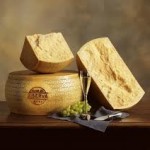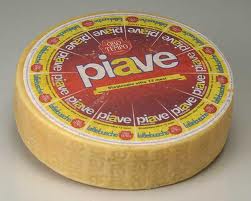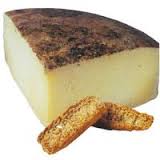We all know that Italy is the home port of all good things to eat and drink. From the king of all cheeses; Parmigiano Reggiano to the wine of kings; Barolo, Italian imported foods and wines are on top of everyone shopping list. However with over 700 varieties of grapes grown in Italy and some 300 cheeses, it is easy to overlook many of the lesser known selections. Here is a quick bucket list of 5 unique Italian cheeses and a wine suggestion to accompany them.
Taleggio: Soft and creamy this cheese is made from cow’s milk in the Lombardy region of Italy. With a thin outer rind, many people considered this a stinky cheese. The moist texture lends itself well to spreading on bread, crackers or Italian flatbreads. The one problem with Taleggio is that you cannot stop eating it. Taleggio pairs well with wines like Barolos or Barbaresco made using the Nebbioli grape. If you really want to go out on the edge try the hard to find Sforzato, a red from northern Lombardy. The sweetness of this wine matches perfectly with the softness of the Taleggio. If you have a good stuffed mushroom recipe, melt a piece of Taleggio to the top, pour a glass of Sforzato and make it a great recipe
Grana Padano: We stay in Lombardy for our next selection. Grana Padano is a hard, flaky cow’s milk creation that many who know Italian Chesses consider the sister to Parmigiano Reggiano. Made in a similar style to Parmigiano Reggiano this cheese can be used as both a table cheese and for grating. Grana Padano is strong and fragrant and always a few dollars less per pound that Parmigiano Reggiano. A great grape variety for this cheese is Barbera d’Asti or Barbera d’Alba. Barbera is ripe on the nose with added hints of smoke, chocolate and vanilla and is found in many regions in Italy including Lombardy. I always think it wise to pair food and wines from the same region. Want to wake up a boring sandwich, add some slivers of Gran Padano, and feel the flavor explode.
Piave: A semi hard cow’s milk cheese that is excellent for grating and as a table cheese. Piave is from the Vento region, and depending upon the age it will come in varying degrees of hardness and taste. For my money I prefer a Piave that matures for more than 120 days as opposed to the softer varieties with less age. Piave, is sometimes compared to Parmigiano Reggiano, but tends to be nuttier and softer. Piave shavings work well on salads and on sandwiches but I love just grabbing a chunk with some flatbreads. Moving away from the cheese and wine same region school of thought, Piave is best served with a robust Italian red like Aglianico. Aglianico is mostly found in the south of Italy in the region of Campania and Puglia.
Formaggio Ubriaco: Formaggio Ubriaco translates literally to “Drunken Cheese.” It gets this name due to the fact that cheese makers wrap this cheese in grape leaves after the grape harvest. Some stories suggest that the cheese was actually fermented in wine barrels so cheese makers could hide it from the tax collector. Whatever the reason, this is a truly unique cheese from Vento that goes real well with fruit, especially figs, apples and other autumn delights. Go with a nice sparkling white like Prosecco also from Vento. This tangy wine makes a perfect low cost compliment to you cheese and fruit platter.
Piacentino: No Italian Cheese conversation would be complete without us heading to the island of Sicily. Piacentino is made from sheep’s milk, with saffron and black peppercorns added. A semi hard cheese that you would expect to be very strong in taste, but is actually mild. Piacentino can be used as a table cheese or its shaving can be added to pasta dishes, especially ravioli. Stay in Sicily for the wine pairing here and go with a selection like Nero d’Avola. A full bodied red often compared to Syrah, this is Sicily’s most popular red and should not be overlooked.
Related articles










Top post. I look forward to reading more. Cheers